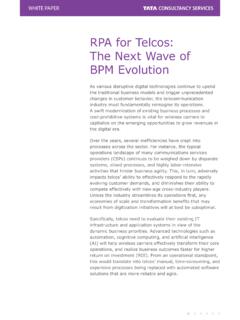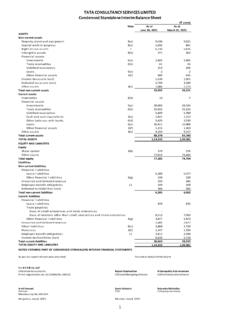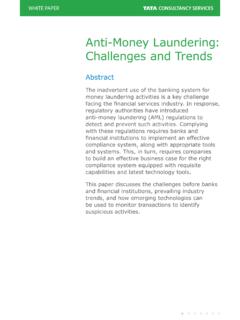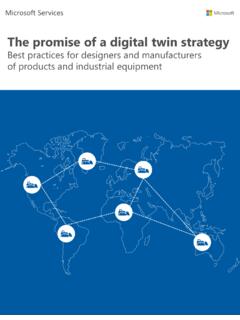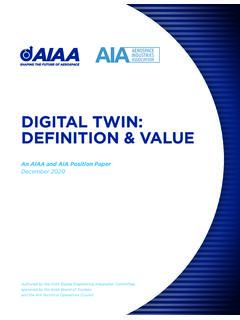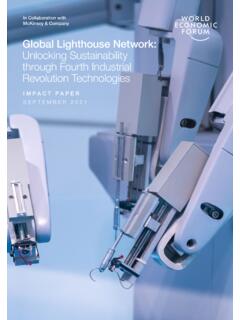Transcription of Digital Twin in the Automotive Industry: Driving Physical ...
1 Digital twin in the Automotive industry : Driving Physical - Digital ConvergenceAbstractIn the past few decades, mass production, lean adoption, and globalization were the key enablers for the Automotive industry to drive growth and pro tability. However, with data becoming the new oil and industry taking hold, future growth of the industry is expected to be fueled by data-led manufacturing. Under this model, enterprises leverage data across the product life cycle to build faster, cost effective, and high quality products. A key enabler of data-driven manufacturing is the concept of Digital twin . It represents a pairing of virtual and Physical worlds underpinned by emerging technologies such as IoT, 3D simulation tools, and predictive analytics .
2 The result: enhanced ability to analyze data and monitor systems to solve the problems even before they occur. The paper explores the role of Digital twin in addressing the current challenges of the Automotive industry , especially with regards to vehicle product design, manufacturing, sales, and PAPERD igital twin : Steering the Auto industry towards Data MaturityThe Digital twin is composed of three components - the Physical entities in the real world, their virtual models, and the connected data/view that ties the two worlds together (see Figure 1). The left half of the gure represents the Physical road ahead and its virtual image on the satellite navigator (SatNav).
3 In this scenario, the driver needs to do three things: view the satellite navigator (SatNav) for direction, view the actual road, overlay the SatNav direction mentally into the actual road to take the right turn. This requires mental effort, some degree of Driving experience, and a sense of timing. In the right half of the gure, the vehicle uses Augmented Reality (AR) capability, giving the driver a converged view of Digital and Physical worlds to seamlessly navigate the turns on the road. This minimizes mental effort, distraction, and chances of human error by allowing the driver to focus on the road. This concept can be extended across the Automotive value chain to perform operations ef ciently by leveraging different technology capabilities underpinned by IoT, Big Data analytics , and simulation PAPERF igure 1: The concept of Digital twin in a Driving scenarioDigital WorldReal WorldConverged ViewDigital twin = Connection between real and Digital worldDigital TwinIn the Automotive industry , the product life cycle of a vehicle involves various stages - conceptualize, design, procure, build, stock, sell, service, and recycle.
4 At each stage, an enormous amount of data is generated as part of routine activities (illustrated in Figure 2). Leveraging the available data to build faster, cost-effective, and high quality products is the ultimate goal of all organizations. However, the fact is that Automotive manufacturers are at different levels of maturity in terms of effective utilization of their data. Driving Past the Challenges Ensuring accurate vehicle design, seamless manufacturing, and exceptional sales and service have been long standing challenges for Automotive manufacturers. Leveraging the Digital twin concept can help turn that equation around.
5 Here s how: Vehicle DevelopmentAutomotive product development is a long and complex process. Typically, manufacturing a new car model takes ve to 1 six years- from design to launch. In fact, effective design is the key to success and long term sustainability of an Automotive organization. Even a small oversight in product design can erode the company s brand value and pro tability. Take for instance Mercedes Benz. The company launched its A-Class in early 2000, at a product development cost of USD 2billion. After its launch, the vehicle failed a Moose test, WHITE PAPERF igure 2: A view of product life cycle data ( Automotive ) Supplier data Material data Equipment's Tools Operators Shop oor capacity constraints Historical data Product con gurations Order details Dealer details Customer details Promise date of delivery Accessories Product subscriptions Product con guration Material, Mechanic Structure, Size Simulations Manufacturing,process parameters Fault data Redesign data Sale date Repurchased product details Residual valu Customer loyalty scores Promotions/Offers Feedback/Surveys Production plans Process control data Production execution data Product quality Material replenishments (shortages)
6 Service history Diagnostics data Vehicle modi cations Odometer readings Warranty data Telematics data Data registered with customer service Recall campaigns Surveys* This list is indicative only (not exhaustive)Product ConceptProduct DesignManufacturingPlanningManufacturing ExecutionProduct SalesProduct Usage &MaintenanceProductRenewal Customer preferences/feedback Product Sales Market competition Investment Plan Aesthetic Design Product Functions Historical DataWHITE PAPER resulting in the recall of 2500 new cars. Subsequently, Mercedes added stability control and redesigned the car's suspension to address the problem. The cost of implementing the change was 2a staggering USD 250 3 details the challenges faced by design and product engineering teams during the vehicle design stage, and the role of Digital twin in addressing ManufacturingMore than a century ago, Henry Ford s innovation reduced the time to build a car from more than 12 hours to two hours.
7 Since then, the industry has seen multiple disruptions and innovations. Now a car comes out of the assembly line every 30 seconds, and not all of them are black . The machine under the hood has evolved from a modest mechanical marvel to a complex and intelligent system comprising an array of technologies, electronics, and fast and smooth manufacturing process depends on the robustness of resource management, production plan, and process control. Today, models and variants in production have increased manifold to keep up with the demand for customized Figure 3: A snapshot of the product development life cycle, its challenges, and the role of Digital twin in mitigating them Target Market De nition Competitor vehicle benchmarking Expansion of design (Feature USPs) Vehicle concept nalisation Re nement of product design (functions ,appearance, styling, con guration parameters)
8 Development of tools and equipment to be used in commercial production Simulation tests to align the product prototype with the desired performance Feasibility and validation of detailed design through production of vehicle in small lots Physical testing of the vehicles (road tests under various climate conditions) Marketing activities (collaterals, teasers, press, media etc.)Activities Target Market De nition Competitor vehicle benchmarking Expansion of design (Feature USPs) Vehicle concept nalisation Re nement of product design (functions ,appearance, styling, con guration parameters) Development of tools and equipment to be used in commercial production Simulation tests to align the product prototype with the desired performance Feasibility and validation of detailed design through production of vehicle in small lots Physical testing of the vehicles (road tests under various climate conditions) Marketing activities (collaterals, teasers, press, media etc.)
9 Re nement of product design involves multiple iterations of simulation tests which are time consuming and often lacks comprehensive coverage of scenarios under real environment conditions. Any alterations in the design in the later stages impacts multiple tracks of design including (tools, equipment, material sourcing , launch timelines) Small volume trial production to con rmthe feasibility of design extends the timelines of product launch and add burden on company s balance sheet. It is too late a stage for the company to work retrospectively , if they need to accommodate any major change in the Digital twin can potentially integrate all the data between previous generation vehicles and current vehicle concept in its Digital model.
10 Communication between designers, stakeholders and end customers (product clinics) can be more interactive and faster Data led decision making to nalise the vehicle concept can be enabled in the organisation. Digital twin is expected to hold the complete data of product lifecycle. Leveraging Digital twin at this stage can bridge this data gap to improve the performance of simulation tests. Reusability of proven models and simulations can enable rapid assessment of change impacts and early discovery of issues Digital twin can potentially integrate all the data between previous generation vehicles and current vehicle concept in its Digital model.

